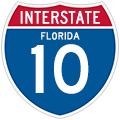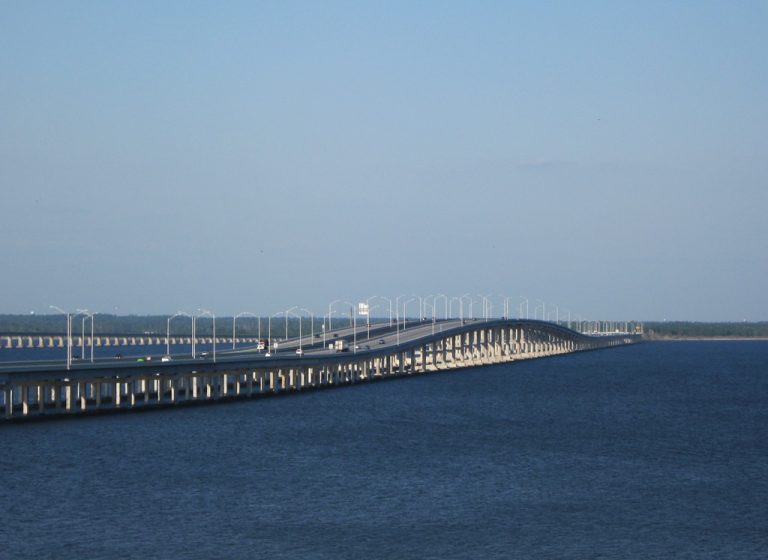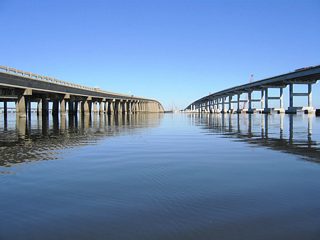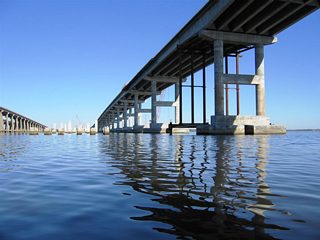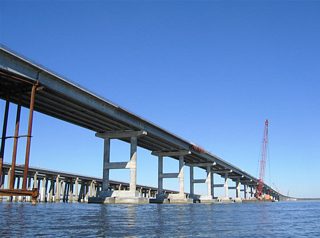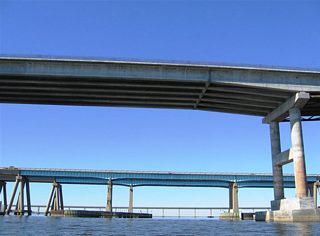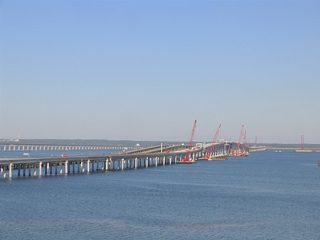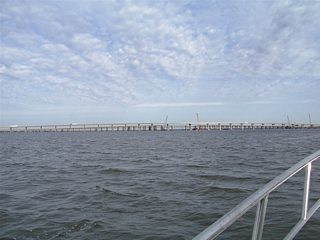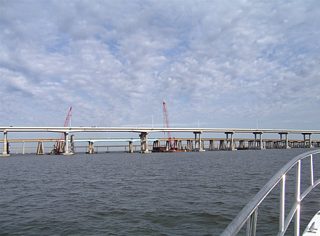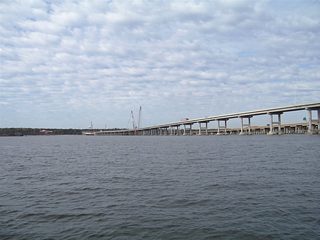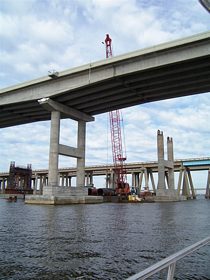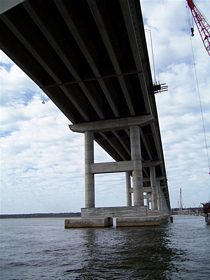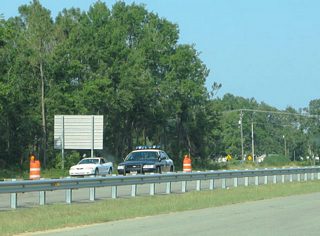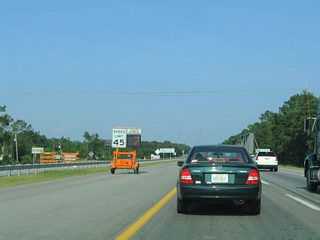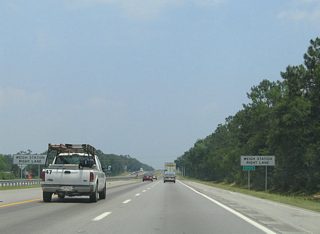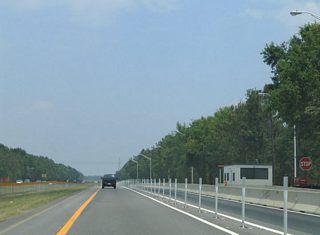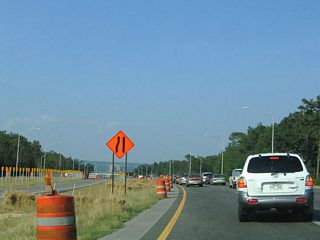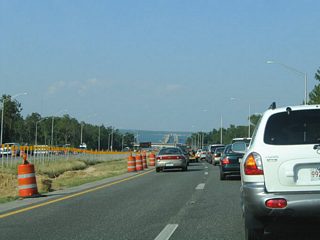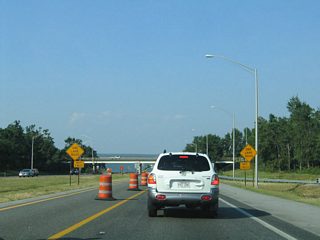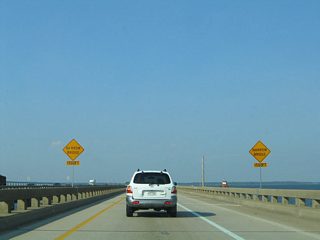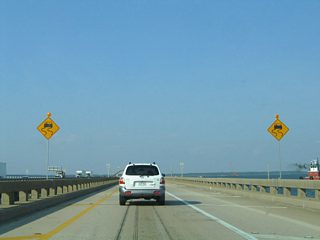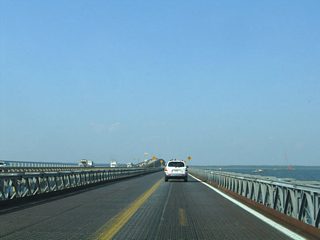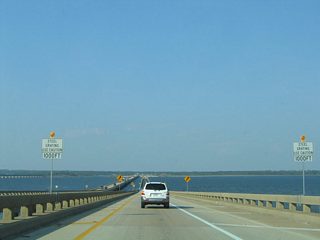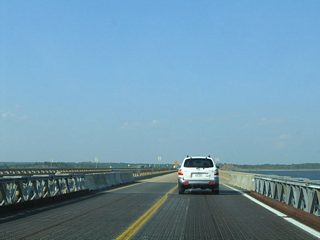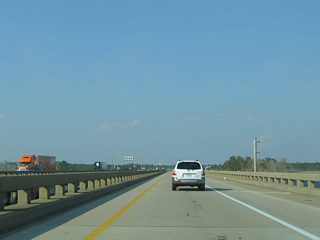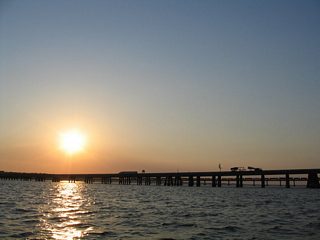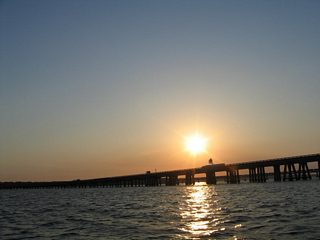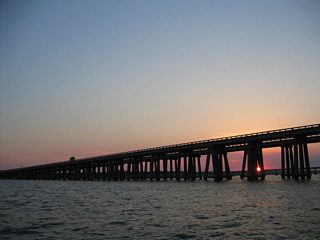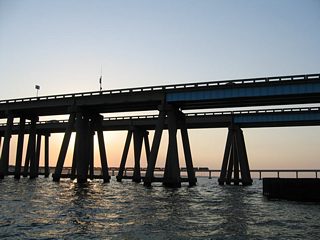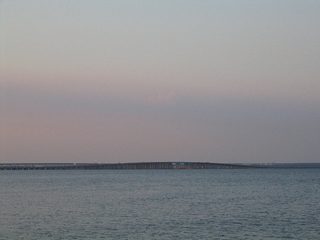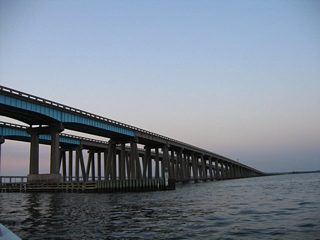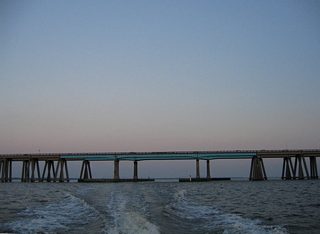The Escambia Bay Bridges of Interstate 10 were the only original spans along Interstate 10 in Escambia and Santa Rosa Counties not replaced by late 1990s and early 2000s upgrade projects. Built during initial construction of the freeway between 1962 and 1967, the bridges rose just 12 feet above the bay.
A view of the Escambia Bay Bridges (Interstate 10) from a bluff near Rock Point. 09/27/08
Hurricane Ivan made landfall between Fort Morgan and Gulf Shores, Alabama in southern Baldwin County on early Wednesday morning September 15, 2004. The category 4 storm made landfall on the Gulf Coast with 130 mile per hour sustained winds and storm surges varying between 10 and 15 feet. The storm was traveling north northeast at the time of landfall, thus putting the northeast quadrant of the hurricane and eye wall across both Baldwin and Escambia Counties. The land falling storm caused extensive property damage, washed out area roads, took a number on the environment, and claimed countless lives. Impacts from the major hurricane disrupted travel along Interstate 10 for two years.
Interstate 10 Bridge Closure
The bridges that carry Interstate 10 travelers over Escambia Bay suffered tremendous damage from the storm surge of Hurricane Ivan. High waters pushed 58 spans off the east and westbound spans into the brackish waters below and shifted an additional 66 segments out of alignment.1 Both spans were closed due to the land falling hurricane, resulting in major detours to the north.
Emergency repairs reopened the westbound span for traffic at 6:30 AM on Tuesday October 5, 2004.3 That bridge provided Interstate 10 with one lane of capacity per direction. Work continued at a rapid pace to reopen the eastbound crossing on November 27, 2004, with a capacity of one lane. The structural integrity of both spans remained in question and high load bearing vehicles and permit loads were prohibited from using either bridge.
Gilbert Southern Corporation of Sunrise, Florida won the $26.5 million repair contract to fix the westbound span across the Escambia Bay. The contractor completed the job in 18 days; six days ahead of schedule. Work commenced on September 18, 2004 and the contractor received $1.5 million in bonuses for the early completion.2 Work involving the eastbound bridge followed. That construction was slated to take at least 90 days with an anticipated completion in late December 2004. Contractors beat that time table with a quick reopening on November 27, 2004.
Damage to the eastbound span was more severe than first thought and it was unclear as to whether or not the bridge would be able to accommodate two lanes of travel. Plans to repair the bridges with temporary metal spans were abandoned due to the amount of materials required and the excessive loads that two lanes of traffic would entail. Furthermore the loads on the westbound span were thought to be too much for the bridge to carry. Thus it was only practical to believe that both bridges would carry just one lane of travel per direction with a full shoulder for emergency vehicle usage. All of this led officials to seek money for a replacement span for the ailing bridges.4
In January of 2005, FDOT awarded a contract to a design-build team for the construction of replacement spans. Construction commenced immediately thereafter on a new four-lane span to carry two lanes of Interstate 10 in each direction. The original timetable looked to have at least one new span opened by the end of 2006--which occurred December 19, 2006. At that time construction continued on a second span to increase the number of lanes for Interstate 10 from four to six over Escambia Bay. That work continued with an anticipated completion date of November 2007--the bridge opened December 12, 2007. Additional details can be found at the AARoads Blog: Bridging Escambia Bay, Florida (March 14, 2007).
Pensacola's Carmageddon
In June of 2005, construction was underway involving pile testing and other "groundwork" for the first replacement span. Traffic on the existing spans was relegated to just one lane with strict weight restrictions in place. Tractor trailers that used the span were required to enter make shift weigh stations regardless of direction travel. In addition, two single-lane metal spans were used along the eastbound bridge. These connections replaced sections of the bridge that were completely destroyed by Ivan. Due to the temporary nature of the metal crossings, tractor trailers were required to span the bridges one at a time. That coupled with a 15 mph speed limit resulted in 15-90 minutes of extra travel time per motorist during the busiest times of day.
Fortunately, the restrictions and long-distance detour for overweight vehicles ended on December 19, 2006 when contractors opened the newest Interstate 10 bridge. With both spans opened by December 12, 2007, motorists now notice an unusual kink along the spans that ties them into the original Interstate 10 footprint below U.S. 90 (Scenic Highway). The curve was a design element required in order to keep I-10 open during the two-year construction period for the new bridges. Locals dubbed the new span the "Crooked Bridge" because of the bridge jog.
Interstate 10 Escambia Bay Bridge Construction
|
| The new eastbound Escambia Bay Bridge as it appeared one month before completion. 11/23/06 |
|
| The last of the concrete deck is poured on November 25, 2006. Pictured here is the bridge from the U.S. 90 (Scenic Highway) over look at a nearby gas station. 11/25/06 |
|
| Vehicles travel across the new "Crooked Bridge" as crews prepare to dismantle the original twin span. 03/03/07 |
|
| Test piles give way to actual piles for the new westbound span near the Escambia Bay channel. 03/03/07 |
|
| A Florida Highway Patrol officer kept an eye on traffic just east of the interchange with SR 291. With traffic partitioned into one through lane for cars and one truck lane through the upcoming temporary weigh station, speed limits dropped to 45 mph as I-10. 05/26/05 |
|
| Despite the 45 mph speed limit, 7 miles per hour was "good" for traffic movement during the evening peak hours. It took 90 minutes to travel between Exit 13 and the east end of the Escambia Bay Bridges during the afternoon of May 26, 2005. 05/26/05 |
|
| Approaching the lane partition for the truck weigh station. As seen during midday, I-10 was noticeably less traffic-choked then after 3 pm. Traffic at the bridge however still crawled, but the four miles between SR 291 and U.S. 90 (Exit 17) were free flowing for the most part. 05/23/05 |
|
| Unfortunately the right lane defaulted into the truck weigh station. The facility used the "weigh in motion" technology, so to help speed up the process. If a truck violated the weight restriction, lane control signals overhead indicated for the driver to pull over to the corral lane. Passenger vehicle drivers unaware of the weigh station in the right lane could trudge through the facility at around 5 mph without stopping. 05/23/05 |
|
| A look at the temporary weigh station house situated along Interstate 10 eastbound for the bridge project. The lane beyond the concrete barrier was the corral lane where overweight trucks were directed. All trucks exceeding weight restrictions were required to leave Interstate 10 via Exit 17 for U.S. 90 (Scenic Highway). 05/23/05 |
|
| Traffic came to a standstill at the approach to Escambia Bay and the folded diamond interchange with U.S. 90 (Scenic Highway). The left lane merged with the right lane ahead of the U.S. 90 overpass. Drivers jockeying for position slowed the process even more. 05/26/05 |
|
| Traffic cones shunted left-lane motorists into the right lane beyond the Exit 17 ramp departure. The on-ramp from U.S. 90 (Scenic Highway) to I-10 eastbound was closed to prevent additional congestion from merging traffic on the right. 05/26/05 |
|
| "One lane road next three miles" signs that were posted at the Scenic Highway overpass. Traffic crawled eastward from this point into Santa Rosa County, regardless of the time of day due to the strict weight restrictions placed upon tractor trailers. 05/26/05 |
|
| A series of warning signs advised motorists of the lane configuration and other hazards associated with the one-lane eastbound span. Slippery road signs were in place for the metal-deck crossings for good reason. 05/26/05 |
|
| Lowering into Santa Rosa County, eastbound traffic oozed toward the second temporary metal span. All guide signs along the eastbound span were toppled by the hurricane as well. 05/26/05 |
|
| Northwestward facing views of Interstate 10 over Escambia Bay. 43,500 vehicles per day traveled the Interstate 10 Escambia Bay Bridges in 2002 (source: FLDOT 2002 Florida Traffic Information cd-rom). The twin spans traveled approximately 2.5 miles across the northern reaches of Escambia Bay. 05/07/04 |
|
| Peering at the I-10 Escambia Bay Bridges and the CSX Railroad span from waters to the southwest. The September 15, 2004 landfall of Hurricane Ivan knocked out several bridge segments due its powerful storm surge. FDOT traffic counters indicated that only three vehicles traveled the westbound span in the hour leading up to the eye wall. 46-year old truck driver Robert Alvarado, hauling a trailer full of fruits and vegetables to Miami, was caught on the eastbound span during the height of the storm. His tractor trailer tumbled into the bay, claiming his life.4 05/07/04 |
|
| Looking south at the Interstate 10 bridges. The westbound span reopened to traffic only 18 days after repair work began. 05/07/04 |
Sources:
- "I-10 bridge reopens; Gov. Bush thanks speedy crews." The Pensacola News Journal, October 5, 2004.
- "I-10 bridge, destroyed by Hurricane Ivan, to reopen Tuesday." The Florida Times-Union. October 4, 2004.
- "Westbound lanes of I-10 bridge open Tuesday." The Pensacola News Journal, October 4, 2004.
- "Escambia Bay bridge work could take years." The Pensacola News Journal, November 5, 2004.
- 05/07/04 by AARoads.
- 05/23/05 by AARoads.
- 05/26/05 by AARoads.
- 11/23/06 by AARoads and Justin Cozart.
- 11/25/06 by AARoads and Justin Cozart.
- 03/03/07 by Alan Nitzman.
Page Updated 07-29-2011.
